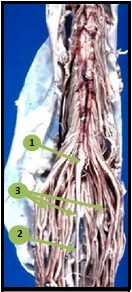Cauda Equina: Difference between revisions
No edit summary |
No edit summary |
||
| Line 5: | Line 5: | ||
</div> | </div> | ||
== Introduction == | == Introduction == | ||
The spinal | [[File:Cauda equina.jpeg|thumb|Cauda equina]] | ||
The cauda equina is a collection of spinal nerves that travel through the lumbar cistern as they leave the vertebral column. The spinal cord is shorter than the vertebral column, which causes nerves that innervate the lower limbs to bundle together as they travel down through the vertebral column to leave at the appropriate level. It is so named as it resemble a horse’s tail. Just above the cauda equina, the spinal cord ends and it continues on as this collection of spinal nerves through the vertebral canal. | |||
== Anatomy == | |||
The spinal cord ends around L1, consequently, the caudal nerve roots below the first lumbar root, form the cauda equina. The roots descend at an almost vertical angle to reach their corresponding foramina, gathered around the filum terminale within the spinal theca. The proximal portion of the cauda equina is said to be hypovascular hence more vulnerable if compressed . The cauda equina has approximately 10 fiber pairs at its base. These consist of 3 to 5 lumbar fiber pairs, 5 sacral fiber pairs, and 1 coccygeal nerve. The primary function of the cauda equina is to send and receive messages between the lower limbs and the pelvic organs, which consist of the bladder, the rectum, and the internal genital organs. | |||
The cauda equina roots have both a anterior and posterior root. | |||
The | # The anterior rami of these spinal nerves contribute to the lumbar and sacral plexuses, which provide motor and sensory innervation to the entire lower limb, pelvic and perineal regions. | ||
# Through their posterior rami, these spinal nerves supply the skin and deep muscles of the lower back, as well as sacral and coccygeal regions<ref name=":0">Ken hub Cauda equina Available:https://www.kenhub.com/en/library/anatomy/conus-medullaris-medullary-cone-and-cauda-equina (accessed 29.4.2022)</ref>. | |||
== | Additionally, the cauda equina provides parasympathetic innervation to the viscera of the pelvic cavity and perineum, including the urinary bladder, descending and sigmoid colon, rectum and both the internal and external reproductive organs. This parasympathetic innervation is also involved in the stimulation of erectile tissues of the external genitalia, enabling erection of the penis/clitoris.<ref>Healthline Cauda equina Available: https://www.healthline.com/human-body-maps/cauda-equina#1<nowiki/>(accessed 29.4.2022)</ref>.<ref>Standring, S (ED IN CHIEF) Grays Anatomy, the anatomical basis of clinical practice 40th edition Churchill Livingstone Elsevier, 2008.</ref><ref>Parke WW, Gammell K, Rothman RH. Arterial vascularization of the cauda equina. J Bone Joint Surg Am 1981; 63: 53–62.</ref><ref>Brash J Jamieson E,(ed) Cunninghams Text book of Anatomy 7th edition. Oxford Medical Publications. 1937.</ref> | ||
== Physio Significance == | |||
[[Cauda Equina Syndrome|Cauda equina syndrome]]: Cauda equina syndrome is caused by a compression or irritation of lumbosacral spinal nerve roots, often due to lumbar disc herniation<ref name=":0" />. | |||
== Sub Heading 3 == | == Sub Heading 3 == | ||
Revision as of 05:50, 29 April 2022
Original Editor - User Name
Top Contributors - Lucinda hampton
Introduction[edit | edit source]
The cauda equina is a collection of spinal nerves that travel through the lumbar cistern as they leave the vertebral column. The spinal cord is shorter than the vertebral column, which causes nerves that innervate the lower limbs to bundle together as they travel down through the vertebral column to leave at the appropriate level. It is so named as it resemble a horse’s tail. Just above the cauda equina, the spinal cord ends and it continues on as this collection of spinal nerves through the vertebral canal.
Anatomy[edit | edit source]
The spinal cord ends around L1, consequently, the caudal nerve roots below the first lumbar root, form the cauda equina. The roots descend at an almost vertical angle to reach their corresponding foramina, gathered around the filum terminale within the spinal theca. The proximal portion of the cauda equina is said to be hypovascular hence more vulnerable if compressed . The cauda equina has approximately 10 fiber pairs at its base. These consist of 3 to 5 lumbar fiber pairs, 5 sacral fiber pairs, and 1 coccygeal nerve. The primary function of the cauda equina is to send and receive messages between the lower limbs and the pelvic organs, which consist of the bladder, the rectum, and the internal genital organs.
The cauda equina roots have both a anterior and posterior root.
- The anterior rami of these spinal nerves contribute to the lumbar and sacral plexuses, which provide motor and sensory innervation to the entire lower limb, pelvic and perineal regions.
- Through their posterior rami, these spinal nerves supply the skin and deep muscles of the lower back, as well as sacral and coccygeal regions[1].
Additionally, the cauda equina provides parasympathetic innervation to the viscera of the pelvic cavity and perineum, including the urinary bladder, descending and sigmoid colon, rectum and both the internal and external reproductive organs. This parasympathetic innervation is also involved in the stimulation of erectile tissues of the external genitalia, enabling erection of the penis/clitoris.[2].[3][4][5]
Physio Significance[edit | edit source]
Cauda equina syndrome: Cauda equina syndrome is caused by a compression or irritation of lumbosacral spinal nerve roots, often due to lumbar disc herniation[1].
Sub Heading 3[edit | edit source]
Resources[edit | edit source]
- bulleted list
- x
or
- numbered list
- x
References[edit | edit source]
- ↑ 1.0 1.1 Ken hub Cauda equina Available:https://www.kenhub.com/en/library/anatomy/conus-medullaris-medullary-cone-and-cauda-equina (accessed 29.4.2022)
- ↑ Healthline Cauda equina Available: https://www.healthline.com/human-body-maps/cauda-equina#1(accessed 29.4.2022)
- ↑ Standring, S (ED IN CHIEF) Grays Anatomy, the anatomical basis of clinical practice 40th edition Churchill Livingstone Elsevier, 2008.
- ↑ Parke WW, Gammell K, Rothman RH. Arterial vascularization of the cauda equina. J Bone Joint Surg Am 1981; 63: 53–62.
- ↑ Brash J Jamieson E,(ed) Cunninghams Text book of Anatomy 7th edition. Oxford Medical Publications. 1937.







